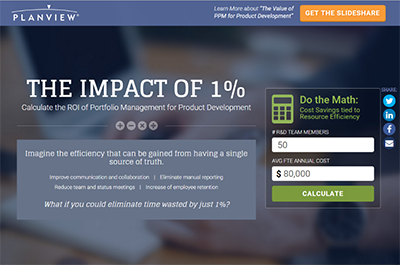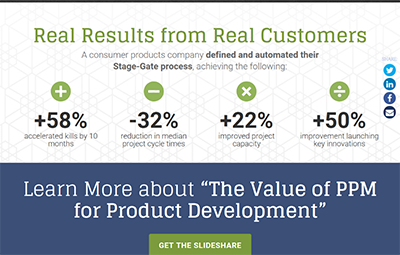

Carrie Nauyalis
New product development (NPD) solution evangelist Carrie Nauyalis is extremely passionate about the ROI of product portfolio management. She likes to walk the walk and talk the talk when it comes to championing a single source of the truth for greater efficiency in bringing products to market.
In fact, she is such an advocate of “doing the math,” she’s created The Impact 1% calculator to show how much product organizations can save by eliminating wasted time. While industry analysts report double digit costs savings, Carrie wanted to demonstrate how moving the needle just one percent could have a positive impact.
For starters, her “Impact of 1%” calculation focuses on connecting savings to resource efficiency. To get a glimpse at the method, I sat down with Carrie for a brief Q&A on the inspiration behind the calculator.
Why Did You Create the Impact of 1% Calculator?
Portfolio management as a discipline and framework for decision making is new to some people in product development. Traditionally, people are more accustomed to evaluating and analyzing projects on a case by case basis and not in the context of the overall portfolio. And as a result, they don’t have any perspective on the measurable value that can be derived leveraging a portfolio management solution like Planview Enterprise. Anyone who has ever had a business conversation with me knows that I’m incredibly passionate about calculating our customers’ return on investment. Whether it’s the revenue gained by getting to market faster, costs cut by killing a product just one gate earlier, or executing against a balanced strategic portfolio that reduces risks – the results are REAL! I created this program to give companies a simple glimpse into the impact even a modest improvement can achieve.
Why Have Product Development Organizations Been Slower Than Their IT Counterparts to Understand the Value of PPM?
IT adopted portfolio management as a discipline more than 20 years ago because they were viewed as a cost to the organization and each department wanted to know the benefits and programs they were going to get based on their investment. After the recession hit here in the United States, I think that many product development budgets were slashed and they were forced to find a new way. They didn’t have a surplus of people and money at their disposal anymore and were forced to make smarter investment decisions. The funny thing is that Dr. Robert Cooper of Stage-Gate fame has been talking about portfolio management as a decision making framework for more than 30 years. But where people miss the mark is that they implement the idea-to-launch process and think they’re done! They use the gated process on single projects and rarely (if ever) look at them in context of the whole portfolio to ensure they will achieve their strategic goals and financial targets. You can go faster with a stage gate process, but what if you’re executing faster on the WRONG PRODUCTS‽ Companies must adopt all four vectors of the Innovation Performance Framework. (Can you tell I have a little bit of passion around this topic?)
For Which Industries is This 1% Calculator Applicable?
The industry doesn’t matter. The numbers work for all verticals. If your company has projects, products, people, and money – this 1% calculator is applicable. This first calculation in the series focuses on a special place in my heart: costs savings tied to resource efficiency. Everyone in product development wants tools to do their job better and faster with less frustration. And PPM can deliver that through project workflow automation, drillable reports, and centralized portfolio decision making. In their report “The ROI of Project Portfolio Management Tools,” Forrester Research states an “average cost reduction of 25% in report generation and manual processes with a central system of records for projects.” Many companies have been limping along with desktop tools and a shared file lsystems believing this is the best technology available. My goal with the Impact of 1% Program, product development professionals will do the calculations for their organizations and understand that THERE IS A BETTER WAY.
What Other 1% Calculators Will You be Launching as Part of This Program?
Delicious question! The link within the calculator to “The Value of Project Portfolio Management for Product Development” Slideshare will give you a great hint. It’s all about shedding light on the math behind the ROI stated by industry analysts around increasing portfolio value, decreasing project duration, and hitting target launch dates. At Planview we are laser-focused on delivering value. It’s woven into our DNA and our implementation methodology. So, it only makes sense that we would want to share that with the product development community. So stay tuned!
I invite you to do the math yourself and learn the truth about the value of 1%! What is your calculation? Is the tool helpful? Share by leaving a comment below.


![Product Portfolio Management in the Digital Era [Webinar]](https://blog.planview.com/wp-content/uploads/2017/09/Product-Portfolio-Management-in-the-Digital-Era-750x400.jpg)

![The 2018 Product Portfolio Management Survey Shines A Light on Top Performers [Video]](https://blog.planview.com/wp-content/uploads/2018/06/PDPM-study.gif)

